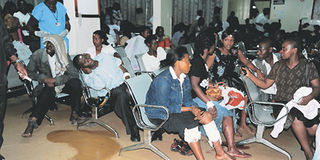How wealth gap dictates access to medical cover

Patients queue at Kenyatta National Hospital. The Kenya Demographic and Health Survey 2022 Report shows far more wealthy individuals have medical insurance compared to poor individuals, underlining the effects of wealth gaps in access to quality and affordable healthcare.
Some 95 per cent of the poor don’t have health cover exposing them to high medical costs in case of ill health, says a new survey.
The Kenya Demographic and Health Survey 2022 Report shows far more wealthy individuals have medical insurance compared to poor individuals, underlining the effects of wealth gaps in access to quality and affordable healthcare.
The findings show that only five per cent of the poorest women have health insurance and only 4.7 per cent of men in the same category.
This is in stark contrast to the 56.2 per cent of the wealthiest women who have health insurance, and 59.9 per cent of the wealthiest men.
“Health insurance coverage increases with increasing wealth, from five per cent among females and males in the lowest wealth quintile to 56 per cent among females and 60 per cent among males in the highest wealth quintile,” said the survey.
This indicates that most individuals in poor households pay for their medical costs from out of pocket, which denies many patients access to healthcare in case they are unable to raise the funds.
NHIF stats
The survey found that one in four persons in Kenya across all economic and age groups including 26 per cent of women and 27 per cent of men are covered with either the National Health Insurance Fund (NHIF), or private commercial and community-based insurance policies. NHIF is the largest health insurer in Kenya with a membership of 15.4 million people.
It also found that more people living in urban areas have health insurance compared with those residing in rural areas indicating that this group of people has more access to job opportunities and finances to take health covers.
“The proportion of persons covered with any health insurance is higher in urban areas (39 per cent among females and 41 per cent among males) than in rural areas (20 per cent among females and 19 per cent among males),” it said.
Kenya has been striving to boost health coverage to more people through the Universal Health Coverage (UHC) that was part of former President Uhuru Kenyatta’s four pillars for socio-economic growth.





